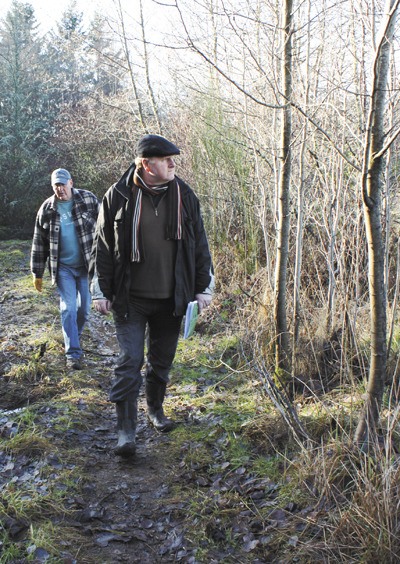The 40-acre forest behind Roseballen is a muddy expanse in places, crisscrossed by deeply rutted tire tracks and pockmarked with debris — food wrappers, discarded needles, an old sleeping bag, clothes.
A small, makeshift cross, marking where one man buried his dog, stands near a spreading hawthorne. The remnants of a camp — a tattered assemblage of tarps, chairs, cardboard and blankets — is tucked behind a wall of ferns, so well-hidden it escaped the bulldozer.
This is where some of Vashon’s homeless people spent their nights and where a handful of Islanders tore through the muck in their rigs — “mud-bogging,” they called it. But the forested parcel is adjacent to Island Center Forest and, perhaps more importantly, holds the headwaters for Judd Creek, a salmon-bearing stream and Vashon’s largest watershed.
And now, after three years of negotiations and a concerted fundraising effort, the parcel is in King County’s hands — its latest acquisition on Vashon and a fantastic addition, some say, to Island Center Forest, a popular, 360-acre park with nine miles of well-used trails.
David Kimmett, a natural lands manager for the county, and Tom Dean, head of the Vashon-Maury Island Land Trust, made their way through the woods last week, commenting on both the needs of the site and its remarkable contribution to Vashon’s swath of public ownership.
With the purchase, Island Center Forest is now 400 acres in size and directly accessible from town, Kimmett said, noting he could see the flag at Vashon’s post office as he stood at the forest’s edge.
The site’s needs are great, Kimmett acknowledged. Scotch broom, a highly invasive plant, covers several acres of it. Years of mud-bogging have taken a toll.
But, he added, “It’s very doable. … There’s a lot of restoration to be done here — and a great opportunity.”
Had the site been developed, Dean added, it would have harmed Judd Creek, which is home to wild runs of coho salmon, considered imperiled by many in the conservation world. With this purchase, he said, the county has taken one more step in protecting some of the last runs in the region.
“This is now Central Park,” he added.
The county purchased the 40-acre site — half of which was zoned industrial — on Dec. 22 for $698,500, money it got from the county’s Conservation Futures fund, which by state law can only be used to acquire open space or resource lands. It bought the property from Roberta Montana, a Seattle woman whose husband at the time purchased the parcel 30 years ago, hoping to eventually build a house on the site.
But the dream unraveled after some family hardships, Montana said, and she found herself owning property that hosted a growing population of homeless people, including — according to some who lived in tents at the site — a number of methamphetamine addicts.
Montana said she’s thrilled that she and the county were able to come to an agreement.
“It’s going to be beautiful,” she said. “And people will walk it and enjoy it long after I’m gone. … The hopes and dreams that were there can now live on somehow.”
Twenty to 25 homeless people were evicted from the parcel in November and December, after Montana — facing a county code violation for the encampment and the debris it was generating — hired a heavy-equipment operator to raze the camps. Those who were living there were told weeks in advance they had to leave, according to the King County Sheriff’s Office.
Nancy Vanderpool, a volunteer with the Interfaith Council to Prevent Home-lessness, said the evictions have been hard on some of the men and women who had camped there. “They’re having to struggle,” she said.
The council was able to help several of them, she said. It purchased a train ticket for a man who has family in California. Another man was given permission to camp on someone’s property, and the council bought him a large tent, she said. A few have gone to Seattle, where they’re living in a shelter. Others have been able to move in with friends.
But the issue highlights the shortage of subsidized housing on Vashon, Vanderpool added.
“Thanks to the community support, we have the finances to do this,” she said, referring to the assistance the council offered some of the men and women. “But I can’t go out and build an apartment. We need housing that is subsidized.”
Meanwhile, Dean and Kimmett are eager to begin the work of restoring the property and building trails, so that the new parcel can begin to provide a connection between the town and Vashon’s largest swath of public land. Indeed, according to Dean, the process can’t start soon enough for him.
“I’ve been working on this for three years,” he said, as he picked his way along a small seasonal stream. “I’m chomping at the bit to get a trail built in here.”



